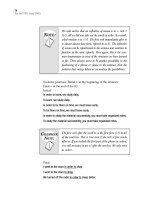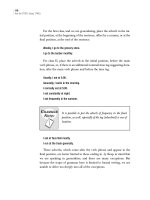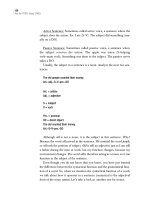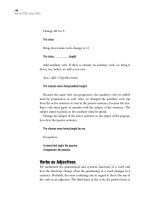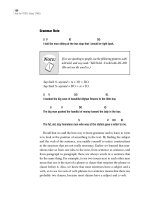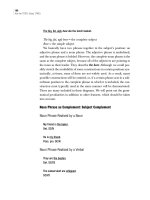Ace the toefl essay part 10
Bạn đang xem bản rút gọn của tài liệu. Xem và tải ngay bản đầy đủ của tài liệu tại đây (180.93 KB, 10 trang )
TOEFL Internals flowed 7/13/07 3:36 PM Page 80
Parts of Speech
Nouns
A noun is the name of a (1) person, (2) place, or (3) thing. Nouns are either
proper or common. For example, the name of a person is a proper noun.
So, when we write the name
Tom Smith, it should be capitalized. However,
the word
boy does not require capitalization. It is a common noun.
The name of a specific place, such as New York, requires capitalization.
It is a certain place, and there is only one New York City at that exact
location. However, a location like the mountains is the name of a place,
but there are many mountains, and one must be specific in order to make
this a
proper noun. A thing may describe an infinite number of possibil-
ities; therefore, most things come under the heading of common nouns,
which generally do not need to take a capital letter. These are some good
examples:
car, ship, house, and computer. Note that if we put a specific name
to the noun, we must capitalize it. For example,
Lexus, Titanic, and Alpha
are all good examples of very specific nouns that require capitalization.
So, we see that there are
proper nouns and common nouns. Proper nouns take
capital letters, and common nouns do not.
CHAPTER FOUR:
Parts of Speech
TOEFL Internals flowed 7/13/07 3:36 PM Page 81
82
Ace the TOEFL Essay (TWE)
One must always capitalize Far East, Middle East, Near
East, North America, South America, Europe
, and
Asia.
There is also a set of nouns that we call abstract. These nouns name
items that are not tangible. One cannot touch them or hold them in his
hand. Arguably, they can be felt. A good example is
grief. One can cer-
tainly feel the death of a family member, but the feeling is abstract,
untouchable.
Happiness, sadness, excitement, danger, and anxiety are all
abstract nouns, and they are not written with capital letters.
Concrete nouns, on the other hand, can be touched. Some examples are
pennies, paper, water, and cups. They are either count or noncount as seen
below.
Count nouns are those that can be physically counted; in other words,
one can see the number of the things at hand, or, better put, in hand.
Boys,
girls, cigarettes, rocks, and fingers are all count nouns. If you can put an s on
the end of the word, it is probably a count noun.
Noncount nouns are those that cannot be counted. Perhaps it is not
impossible, at least sometimes, to count some of these nouns we call non-
count, but it is unlikely that one would try to count these types of nouns.
Sugar, sand, and hair are noncount nouns. Further, water, tea, and cream are
what we would call uncountable, which seems more appropriate.
If we say something like “I had two cups of tea,” then we
can number the actual cups, but not the tea itself.
Usage Note: people, money, food.
THE
:
RE
N
OTE
:
THE
:
RE
N
OTE
:
TOEFL Internals flowed 7/13/07 3:36 PM Page 82
83
Parts of Speech
EXERCISE 4.1
Exercise 4.1
Directions: Label the nouns in each sentence, indicating
C
for
count
,
NC
for
noncount
,
CM
for
common
, and
P
for
proper
. In addi-
tion, capitalize any proper nouns. The answers are always on top
when labeling is required.
C/CM
1. We went to the store.
2. There were bubbles in the water.
3. I had 500 bottles of air.
4. We will have the beef.
5. Whoever said it was wrong.
6. We found a note.
7. The herb was safe.
8. The safety of the men was the issue.
9. Along the way, we went to the statue of liberty.
10. The Midwest was rainy on Thursday.
11. The money earmarked for the interstate highway commission
was misappropriated.
12. Different coffees from around the world provided us quite a variety.
13. The continental divide is a famous tourist attraction.
14. If the manager had known, he would have closed early.
15. At the mall, the angry crowd burned the postal truck.
16. The united states post office is extremely efficient.
17. The girl from micronesia swam very well.
18. School can be rewarding.
19. Religion has been the cornerstone of many people’s lives.
20. Snobbishness is a bad characteristic.
21. Accuracy is necessary in grammar.
22. Being lazy is an unfavorable trait.
23. The desert is extremely hot.
24. If dinosaurs were in this spot a million years ago, we would now
have evidence.
25. Trust is paramount to a good relationship between family
members.
26. Some say that the horse became expendable with the advent
of the modern car.
TOEFL Internals flowed 7/13/07 3:36 PM Page 83
84
Ace the TOEFL Essay (TWE)
27. The germanic languages have similar sentence patterns to
English.
28. He said history is his favorite subject.
29. I said that american history from 1865 to world war I is my
favorite course.
30. Ode to a grecian urn is the name of a poem.
Verbs
Verbs are a little more complicated than most of the other parts of speech.
We will be concerned with several different kinds of verbs here.
Be Verbs
Be verbs are so called because they are conjugations of the verb be. They
include the following: (1) simple present:
is, am, are; (2) simple past: was,
were; (3) simple future: will (be)
We will finish the tenses in the next few pages under “Action Verbs.”
From these three tenses, one can form many different tenses of action.
Tense refers to the time of an occurrence. Let’s look at the be verbs and
the persons that go with them.
Person means the pronoun/name used
with the verb.
Look at the list below and the pronouns used with each.
Simple Simple Simple
Present: Past Future
I am. I was. I, you, he, she, it,
they, we + will be
You are. You were.
We are. We were.
They are. They were.
He is. He was.
She is. She was.
It is. It was.
EXERCISE 4.1
TOEFL Internals flowed 7/13/07 3:36 PM Page 84
